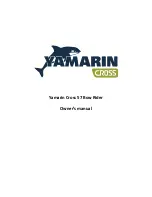
Operating Manual for Sea Daze 4788 Bayliner
Sea Daze 160323.doc
Page 15 of 44
Last Revision August 11
th
, 2015
Remember that sounders do NOT look in front of the boat, only UNDER the boat. They do not tell you if
you are about to run aground, only if you haven’t already. Use them in close conjunction with your charts.
3.4.8
Radar
Sea Daze is equipped with a Raymarine Pathfinder Radar with HSB display. To turn on the radar press and hold
the power button in the lower left of the HSB display unit until the unit beeps. If the system is in Radar mode it
will automatically start the warm-up countdown sequence for the magnetron. After the countdown is complete
the radar will go to standby mode. To initiate transmit you need to press the power button again. The radar
screen should begin to display images of nearby objects. Use the range key to adjust the range scale of the rings.
Press display to zoom in or out to an appropriate scale for navigation. To turn off the radar press and hold the
power button until it completes the countdown.
To read the radar assume you are at the center of the screen. The top of the screen is dead ahead. The higher
the range you are displaying, the more gain you want. Use filters sparingly as they may filter out targets you
are looking for.
If the E127 MFD is on the radar can display speed, direction to waypoint and coordinates to selected targets.
The EBL (estimated bearing line) and the VRM (variable range marker) are extremely useful. These are
operated with the track ball and menu keys.
The operating manual is in the cabinet under the power control panel if you desire more information on radar
system functions.
Note: The HSB display is shared with a 3
rd
backup GPS unit, Raystar 112LP GPS Chart Plotter. The display
should default to display radar, however if it is not showing radar images press display and select the options to
switch between the radar and chart plotter screens.
3.5
Boat Operations
3.5.1
Starting the engines
The hour meters are at the aft side of the power panel in the pilothouse. Record these readings in your log entry
and check the log to see what they read at the last refuel (Experience has shown that fuel gauges are often not
accurate. We suggest that you track your fuel consumption rate as a double check on the fuel gauges)
At the top of the DC switch panel (the aft panel section in the cabinet on the starboard side of the pilothouse)
turn on the DC Master and the Ignition Power switches for the port and starboard engines.
Ignition keys are in the pilothouse starboard drawer. Insert the keys into each key switch in the helm
station.
Place the transmission selector levers (levers with the black knobs to port side) in
the Neutral position and the
throttle controls (levers with the red knobs to starboard) in the idle position
(pulled fully to the aft).
If starting the engines for the first time of the day, make sure to preheat the engines. Turn the Starboard engine
ignition key clockwise until you hear a buzzer (do not attempt to start yet), when the green light above the key
switch comes on turn the key further to the right to start the engine. Wait for the buzzer to stop after starting the
starboard engine before starting the port engine. Follow the same process with the port engine.
















































